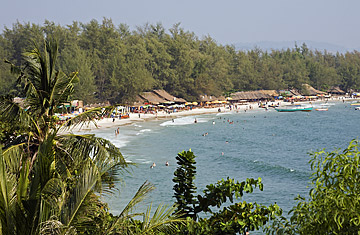
Serendipity Beach in Sihanoukville, Cambodia
Most visits to Cambodia begin with the ancient temples of Angkor Wat or the Khmer Rouge's infamous killing fields just outside Phnom Penh. I'm not saying they're not worth seeing, but on our recent 10-day journey through Cambodia, we visited neither. My husband had already hiked Angkor Wat a couple of months back, and frankly, it just felt too depressing to center an entire vacation on mass murder. So we headed instead to southwestern Cambodia, to the developing coastline, in search of waterfalls and beaches. And we found that the people there were just as welcoming as the landscape.
We flew into Phnom Penh International Airport and took a tuk-tuk (a motorized rickshaw) into town. It was a $5, 45-min., open-air trip on the highway, which probably did bad things to our lungs but helped ease my motion sickness from our wobbly descent to the airport. It also gave us a nice visual primer of the capital, which we were using only as a way station. Looking back, I would have liked at least another day in Phnom Penh to take in the culture — the Royal Palace and Silver Pagoda, for example — and the laid-back, late-going bar scene. As it was, we had time only for dinner at the Foreign Correspondents' Club (363 Sisowath Quay, Phnom Penh; +855-23-210-142), where we stayed the night, and to hit up a couple of bars, including Love Orange — a disco packed with teenagers cheering on the drag-queen lip-synching show.
The next day, it was on to Koh Kong, a coastal frontier town on the Thai border, which until a couple of years ago was best accessed by boat. It is separated from the rest of Cambodia by the Cardamom Mountain range, a dense forest that houses endangered species like the Indochinese tiger and the Malayan sun bear, and used to be a Khmer Rouge stronghold. But a national highway built with help from the Thais, which includes four bridges spanning rivers once crossable only by ferry, has cut the drive to Koh Kong from the capital in half — to four hours.
Koh Kong has one paved road, a blink-and-you'll-miss-it dock and an inordinate number of Germans. The main activity for travelers in this border town is meeting other travelers. Most of the guesthouses and hostels in Koh Kong are run by Europeans and Australians (the proprietor and family usually live on-site) and are good for getting a drink, sitting in a hammock and chatting up your neighbor. They're also good for a cheap ($7 per night) room, if you can endure using a shared toilet. If not, I suggest you stay at the $35-per-night Koh Kong City Hotel (Street 1, Koh Kong; +855-35-936-777) on the waterfront, which is sparse and basic but has decadent, memory-foam-style mattresses and private, Western-style bathrooms. The front-desk service here is lacking, but you'll sleep the sleep of the dead.
The tour outfits in Koh Kong aren't well advertised, but you can get yourself a seat on an organized excursion if you know whom to ask and don't mind surprises. We stumbled randomly on Otto, owner of a guesthouse called Otto's, on our first night in town. We went to his place for dinner (fantastic fried potatoes), and when we asked for advice on local tours, he pulled out his cell phone, dialed his friend Thomas and booked us instantly on a boat excursion for the following morning. His method was efficient if mysterious. Even as we boarded the boat the next morning, we had no idea where we were going or what we would see.
There were eight other travelers aboard our long-tail motorboat, seven of whom were German and most of whom were staying at Thomas' guesthouse, Neptune. Thomas, also German, did the entertaining while our Khmer captain steered with his foot and drank an Angkor beer. The first two hours took us south past islands dotted with stilted fishing villages painted in blues and greens and oranges, then through a mangrove forest, into the Gulf of Thailand. There we hit the jackpot: a school of dolphins jumping in the waves.
We stopped for lunch in a fishing village where Thomas had once stayed a night after being stranded at sea. He made friends with the villagers and now returns often to introduce his tour groups. In general, as tourists, we try not to gawk at the poverty around us, but this was impossible at such close range. About 15 people lined up on the "dock" (really, a front porch) and helped us clamber from our boat over theirs and into their one-room home. There wasn't much dialogue between the groups, given that none of the tourists spoke Khmer and our hosts didn't know English, but there was much smiling and cooing at the babies, one of whom was cooling off in a pot of water. We ate stir-fried veggies and tofu with a cabbage salad, sitting cross-legged on the floor. Through the slats, you could see the water a few feet below. The hospitality was free: Thomas brought our lunch and gave our hosts a case of beer as a token of friendship.
Another sail took us to Koh Kong Island, a lush national forest where recreational exploration is forbidden. We dropped anchor off a deserted white-sand beach and hopped overboard into the clear, warm sea. The water was probably 70° and not more than 5 ft. deep, with gentle waves that glimmered in the late-afternoon sun. Then, sated and relaxed, we motored home.
Read TIME's stories about romance on the road.
Got an awful travel gripe? The Avenger may be able to sort it out for you. Click here to tell us your problem.
